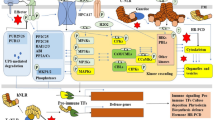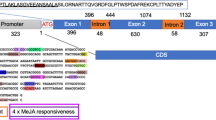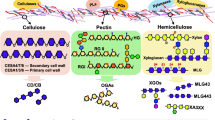Abstract
Phytopathogenic fungi are known to secrete specific proteins which act as virulence factors and promote host colonization. Some of them are enzymes with plant cell wall degradation capability, like pectate lyases (Pls). In this work, we examined the involvement of Pls in the infection process of Magnaporthe oryzae, the causal agent of rice blast disease. From three Plgenes annotated in the M. oryzae genome, only transcripts of MoPL1 considerably accumulated during the infection process with a peak at 72 h post inoculation. Both, gene deletion and a constitutive expression of MoPL1 in M. oryzae led to a significant reduction in virulence. By contrast, mutants that constitutively expressed an enzymatic inactive version of MoPl1 did not differ in virulence compared to the wild type isolate. This indicates that the enzymatic activity of MoPl1 is responsible for diminished virulence, which is presumably due to degradation products recognized as danger associated molecular patterns (DAMPs), which strengthen the plant immune response. Microscopic analysis of infection sites pointed to an increased plant defense response. Additionally, MoPl1 tagged with mRFP, and not the enzymatic inactive version, focally accumulated in attacked plant cells beneath appressoria and at sites where fungal hyphae transverse from one to another cell. These findings shed new light on the role of pectate lyases during tissue colonization in the necrotrophic stage of M. oryzae’s life cycle.
Similar content being viewed by others
References
Bruehlmann, F. 1995. Purification and characterization of an extracellular pectate lyase from an Amycolata sp. Appl. Environ. Microbiol. 61, 3580–3585.
Chen, C., Lian, B., Hu, J., Zhai, H., Wang, X., Venu, R.C., Liu, E., Wang, Z., Chen, M., Wang, B., et al. 2013. Genome comparison of two Magnaporthe oryzae field isolates reveals genome variations and potential virulence effectors. BMC Genomics 14, 887.
Choi, J., Kim, K.T., Jeon, J., and Lee, Y.H. 2013. Fungal plant cell wall-degrading enzyme database: a platform for comparative and evolutionary genomics in fungi and Oomycetes. BMC Genomics 14, S7.
Choi, H.W. and Klessig, D.F. 2016. DAMPs, MAMPs, and NAMPs in plant innate immunity. BMC Plant Biol. 16, 232.
Cnossen-Fassoni, A., Bazzolli, D.M.S., Brommonschenkel, S.H., Fernandes de Araújo, E., and de Queiroz, M.V. 2013. The pectate lyase encoded by the pecCl1 gene is an important determinant for the aggressiveness of Colletotrichum lindemuthianum. J. Microbiol. 51, 461–470.
Crawford, M.S. and Kolattukudy, P.E. 1987. Pectate lyase from Fusarium solani f. sp. pisi: Purification, in vitro translation of the mRNA, and involvement in pathogenicity. Arch. Biochem. Biophys. 258, 196–205.
Dean, R.A., Kan, J.A.L., Pretorius, Z.A., Hammond-Kosack, K.E., Di Pietro, A., Spanu, P.D., Rudd, J.J., Dickman, M., Kahmann, R., Ellis, J., et al. 2012. The Top 10 fungal pathogens in molecular plant pathology. Mol. Plant Pathol. 13, 414–430.
Dean, R.A., Talbot, N.J., Ebbole, D.J., Farman, M.L., Mitchell, T.K., Orbach, M.J., Thon, M., Kulkarni, R., Xu, J.R., Pan, H., et al. 2005. The genome sequence of the rice blast fungus Magnaporthe grisea. Nature 434, 980–986.
Dean, R.A. and Timberlake, W.E. 1989. Production of cell wall-degrading enzymes by Aspergillus nidulans: A model system for fungal pathogenesis of plants. Plant Cell 1, 265–273.
Delventhal, R., Falter, C., Strugala, R., Zellerhoff, N., and Schaffrath, U. 2014. Ectoparasitic growth of Magnaporthe on barley triggers expression of the putative barley wax biosynthesis gene CYP96B22 which is involved in penetration resistance. BMC Plant Biol. 14, 26.
Dong, Y., Li, Y., Zhao, M., Jing, M., Liu, X., Liu, M., Guo, X., Zhang, X., Chen, Y., Liu, Y., et al. 2015. Global genome and transcriptome analyses of Magnaporthe oryzae epidemic isolate 98-06 uncover novel effectors and pathogenicity-related genes, revealing gene gain and lose dynamics in genome evolution. PLoS Pathog. 11, e1004801.
Ebbole, D.J. 2007. Magnaporthe as a model for understanding hostathogen interactions. Annu. Rev. Phytopathol. 45, 437–456.
Elmore, J.M. and Coaker, G. 2011. The role of the plasma membrane H+-ATPase in plant-microbe interactions. Mol. Plant 4, 416–427.
Guo, W., González-Candelas, L., and Kolattukudy, P.E. 1995. Cloning of a novel constitutively expressed pectate lyase gene pelB from Fusarium solani f. sp. pisi (Nectria haematococca, mating type VI) and characterization of the gene product expressed in Pichia pastoris. J. Bacteriol. 177, 7070–7077.
Herron, S.R., Benen, J.A., Scavetta, R.D., Visser, J., and Jurnak, F. 2000. Structure and function of pectic enzymes: Virulence factors of plant pathogens. Proc. Natl. Acad. Sci. USA 97, 8762–8769.
Hou, S., Liu, Z., Shen, H., and Wu, D. 2019. Damage-associated molecular pattern-triggered immunity in plants. Front. Plant Sci. 10, 646.
Houston, K., Tucker, M.R., Chowdhury, J., Shirley, N., and Little, A. 2016. The plant cell wall: a complex and dynamic structure as revealed by the responses of genes under stress conditions. Front. Plant Sci. 7, 984.
Jarosch, B., Collins, N.C., Zellerhoff, N., and Schaffrath, U. 2005. RAR1, ROR1, and the actin cytoskeleton contribute to basal resistance to Magnaporthe grisea in barley. Mol. Plant Microbe Interact. 18, 397–404.
Jarosch, B., Jansen, M., and Schaffrath, U. 2003. Acquired resistance functions in mlo barley, which is hypersusceptible to Magnaporthe grisea. Mol. Plant Microbe Interact. 16, 107–114.
Jeon, J., Lee, G.W., Kim, K.T., Park, S.Y., Kim, S., Huh, A., Chung, H., Lee, D.Y., Kim, C.Y., and Lee, Y.H. 2020. Transcriptome profiling of the rice blast fungus Magnaporthe oryzae and its host Oryza sativa during infection. Mol. Plant Microbe Interact. 33, 141–144.
Jones, J.D.G. and Dangl, J.L. 2006. The plant immune system. Nature 444, 323–329.
Kankanala, P., Czymmek, K., and Valent, B. 2007. Roles for rice membrane dynamics and plasmodesmata during biotrophic invasion by the blast fungus. Plant Cell 19, 706–724.
Kanungo, A. and Prasad, B. 2019. Structural insights into the molecular mechanisms of pectinolytic enzymes. J. Proteins Proteom. 10, 325–344.
Keegstra, K. 2010. Plant cell walls. Plant Physiol. 154, 483–486.
Leisen, T., Bietz, F., Werner, J., Wegner, A., Schaffrath, U., Scheuring, D., Willmund, F., Mosbach, A., Scalliet, G., and Hahn, M. 2020. CRISPR/Cas with ribonucleoprotein complexes and transiently selected telomere vectors allows highly efficient marker-free and multiple genome editing in Botrytis cinerea. PLoS Pathog. 16, e1008326.
Levy, A., Salas Gonzalez, I., Mittelviefhaus, M., Clingenpeel, S., Herrera Paredes, S., Miao, J., Wang, K., Devescovi, G., Stillman, K., Monteiro, F., et al. 2018. Genomic features of bacterial adaptation to plants. Nat. Genet. 50, 138–150.
Livak, K.J. and Schmittgen, T.D. 2001. Analysis of relative gene expression data using real-time quantitative PCR and the 2−ΔΔCT method. Methods 25, 402–408.
Loehrer, M., Botterweck, J., Jahnke, J., Mahlmann, D.M., Gaetgens, J., Oldiges, M., Horbach, R., Deising, H., and Schaffrath, U. 2014. In vivo assessment by Mach-Zehnder double-beam interferometry of the invasive force exerted by the Asian soybean rust fungus (Phakopsora pachyrhizi). New Phytol. 203, 620–631.
Miyara, I., Shafran, H., Kramer Haimovich, H., Rollins, J., Sherman, A., and Prusky, D. 2008. Multi-factor regulation of pectate lyase secretion by Colletotrichum gloeosporioides pathogenic on avocado fruits. Mol. Plant Pathol. 9, 281–291.
Mogga, V., Delventhal, R., Weidenbach, D., Langer, S., Bertram, P.M., Andresen, K., Thines, E., Kroj, T., and Schaffrath, U. 2016. Magnaporthe oryzae effectors MoHEG13 and MoHEG16 interfere with host infection and MoHEG13 counteracts cell death caused by Magnaporthe-NLPs in tobacco. Plant Cell Rep. 35, 1169–1185.
Mori, T., Jung, H.Y., Maejima, K., Hirata, H., Himeno, M., Hamamoto, H., and Namba, S. 2008. Magnaporthe oryzae endopolygalacturonase homolog correlates with density-dependent conidial germination. FEMS Microbiol. Lett. 280, 182–188.
Quoc, N.B. and Chau, N.N. 2017. The role of cell wall degrading enzymes in pathogenesis of Magnaporthe oryzae. Curr. Protein Pept. Sci. 18, 1019–1034.
Saitoh, H., Fujisawa, S., Mitsuoka, C., Ito, A., Hirabuchi, A., Ikeda, K., Irieda, H., Yoshino, K., Yoshida, K., Matsumura, H., et al. 2012. Large-scale gene disruption in Magnaporthe oryzae identifies MC69, a secreted protein required for infection by monocot and dicot fungal pathogens. PLoS Pathog. 8, e1002711.
Shimizu, M., Nakano, Y., Hirabuchi, A., Yoshino, K., Kobayashi, M., Yamamoto, K., Terauchi, R., and Saitoh, H. 2019. RNA-Seq of in planta-expressed Magnaporthe oryzae genes identifies MoSVP as a highly expressed gene required for pathogenicity at the initial stage of infection. Mol. Plant Pathol. 20, 1682–1695.
Skamnioti, P. and Gurr, S.J. 2007. Magnaporthe grisea cutinase2 mediates appressorium differentiation and host penetration and is required for full virulence. Plant Cell 19, 2674–2689.
Talbot, N.J. 2003. On the trail of a cereal killer: exploring the biology of Magnaporthe grisea. Annu. Rev. Microbiol. 57, 177–202.
Underwood, W. 2012. The plant cell wall: a dynamic barrier against pathogen invasion. Front. Plant Sci. 3, 85.
van den Brink, J. and de Vries, R.P. 2011. Fungal enzyme sets for plant polysaccharide degradation. Appl. Microbiol. Biotechnol. 91, 1477–1492.
Voegele, R.T. and Schmid, A. 2011. RT real-time PCR-based quantification of Uromyces fabae in planta. FEMS Microbiol. Lett. 322, 131–137.
Wilson, R.A. and Talbot, N.J. 2009. Under pressure: investigating the biology of plant infection by Magnaporthe oryzae. Nat. Rev. Microbiol. 7, 185–195.
Yakoby, N., Kobiler, I., Dinoor, A., and Prusky, D. 2000. pH regulation of pectate lyase secretion modulates the attack of Colletotrichum gloeosporioides on avocado fruits. Appl. Environ. Microbiol. 66, 1026–1030.
Yoder, M.D., Keen, N.T., and Jurnak, F. 1993. New domain motif: the structure of pectate lyase C, a secreted plant virulence factor. Science 260, 1503–1507.
Yoshida, K., Saitoh, H., Fujisawa, S., Kanzaki, H., Matsumura, H., Yoshida, K., Tosa, Y., Chuma, I., Takano, Y., Win, J., et al. 2009. Association genetics reveals three novel avirulence genes from the rice blast fungal pathogen Magnaporthe oryzae. Plant Cell 21, 1573–1591.
Zheng, X., Zhou, J., Lin, X., Lan, L., Wang, Z., and Lu, G. 2009. Secretion property and gene expression pattern of a putative feruloyl esterase in Magnaporthe grisea. In Wang, G.L. and Valent, B. (eds.) Advances in Genetics, Genomics and Control of Rice Blast Disease. Springer, Dordrecht, Netherlands.
Acknowledgements
The authors would like to thank Matthias Hahn for hosting AW during an internship and guidance in fungal transformation. Asaf Levy is kindly acknowledged for sharing data in advance of publication. Work of AW and FC was financed by RWTH Aachen University scholarships for Doctoral Students.
Author information
Authors and Affiliations
Contributions
AW and FC performed most of the experiments, interpreted results and drafted the manuscript. AJ did experiments related to RT-qPCR analyses. ML and SB designed experiments and helped in the interpretation of the results. XL and ZZ contributed to the final version of the manuscript. US designed experiments and finalized the manuscript. All couthors read and approved the final version.
Corresponding author
Additional information
Conflict of Interest
The authors declare that they have no competing interests.
Data Availability
The data that support the findings of this study are available from the corresponding author upon reasonable request.
Supplemental material for this article may be found at http://www.springerlink.com/content/120956.
Electronic Supplementary Material
12275_2022_1074_MOESM1_ESM.pdf
Gene deletion and constitutive expression of the pectate lyase gene 1 (MoPL1) lead to diminished virulence of Magnaporthe oryzae
Rights and permissions
About this article
Cite this article
Wegner, A., Casanova, F., Loehrer, M. et al. Gene deletion and constitutive expression of the pectate lyase gene 1 (MoPL1) lead to diminished virulence of Magnaporthe oryzae. J Microbiol. 60, 79–88 (2022). https://doi.org/10.1007/s12275-022-1074-7
Received:
Revised:
Accepted:
Published:
Issue Date:
DOI: https://doi.org/10.1007/s12275-022-1074-7




